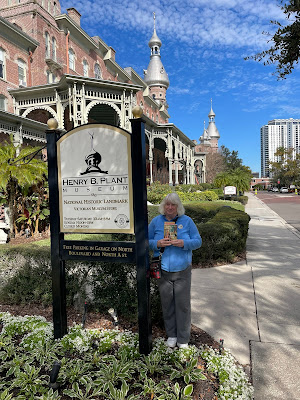Florida has so many places that can be found in various series books that Pam and I had to continue with our adventures! After exploring the Space Coast (
Series Books - the Space Coast) with the Hardy Boys, the Happy Hollisters, and Nancy Drew, and then exploring St. Augustine (
Series Books - the Oldest City) with the Moving Picture Girls, the time came to head over to the west coast to follow in the footsteps of that crime-solving flight attendant, Vicki Barr! That trip was originally planned back in October, but due to the hurricane, plans were changed - which, ultimately worked out for the best, because it gave us the opportunity to visit the Tampa Bay area in January and experience Gasparilla, just like Vicki Barr did!
As with our trip to St. Augustine, we were able to focus on just one book for this trip, and that was the Vicki Barr mystery, The Clue of the Gold Coin. This book is the twelfth book in the Vicki Barr Flight Stewardess series. This series is sort of a companion career series to Cherry Ames (who was a nurse), as both series had the same authors: Helen Wells and Julie Campbell Tatham. This particular book was written by Helen Wells, the original author for the series, and was published in 1958. The story follows Vicki Barr, who was fortunate enough to get a route that would take her to Tampa Bay area, where she could not only visit with some friends, but also experience the pirate festival known as Gasparilla. Vicki stumbles upon a mystery involving gold coins that are stolen from a museum exhibit that was arriving by plane, so of course, her traipsing through Tampa and Ybor City was mostly focused on solving the mystery. Of course, along the way, she visited a number of various places, and it was surprising how many of them Pam and I found in the real world...

The adventure for Vicki began with her flight into the Tampa International Airport, as she looked out the window and "at last the hangars and runways of the Tampa International Airport swept into view..." (p. 4) It was obvious that this would be our first stop as we followed in Vicki's footsteps.
We followed signs to see where the arriving flights would unload. While Vicki flew in to Tampa on Federal Airlines, that is a fictional airline which does not exist in the real world (in the United States, anyway). Thus, we figured the closest we might find would be American Airlines, and we discovered the unloading took place at Blue 125. There were a number of taxis waiting for passengers, which would have been perfect for Vicki, who "went out the building's main entrance to look for a taxi" (p. 12).
Once Vicki is settled into her friends' home, she is invited to join them for Gasparilla. Her hosts provide her with a description of the event, giving her an abbreviated history of the pirate festival (pp. 17-19). Since we did not have those same hosts to share the story, we visited the Henry B. Plant Museum, which provided the history we were seeking!
As the story goes, "...in 1783, to be exact, an officer in the Spanish Navy named Jose Gaspar mutinied ... turned pirate, changed his name to Gasparilla, meaning Little Gaspar, and began to prey on the merchant ships of all nations. He made his headquarters in the islands around Tampa Bay..." (p. 17).
Since the book was published in 1958, it was likely the author visited Tampa the previous year and was able to experience the Gasparilla festival of 1957. We learned that each festival has a "royal court" that includes a King and Queen, along witha group of maids, and the court is an important part of the celebration. At the museum Pam and I visited, we were fortunate enough to see the Jewel Circle Gown worn by a member of the court in 1957, which dress was designed by Anne Lowe, the first internationally recognized African-American fashion designer.
Both the museum and The Clue of the Gold Coin shared the history of how a "group of Tampa businessmen formed an organization called Ye Mystic Krewe..." (p. 18), which has since been joined by more than 60 additional "krewes," all of whom come together each year to contribute to this annual festival. The Tampa Bay Hotel, which now houses the Henry B Plant Museum,was the central location for the early festivals.
From museum, it was only a hop, skip, and a jump (literally!) to the Cass Street Bridge. Now, you may be wondering why would visit a bridge, as what importance could it have had to the Vicki Barr story? Well, as it turns out, the book contains a two-page spread illustration of a drawbridge being lifted so that a pirate ship in the Gasparilla parade could make its way through.
Based on the illustration, there was no doubt the bridge was the Cass Street Bridge, built back in 1926. While the water tower in the background of the illustration is no longer there, the small octagonal building that housed the controls for the bridge is still there! Based on the details in the illustration, either the author provided photographs of the bridge for use in drawing the scene, or the illustrator was familiar enough with it to depict it with such exactness.
Next in the adventure, Vicki was offered a chance to "VISIT GLAMOROUS YBOR CITY - Enchanted Land of Fiesta and Romance" (p. 82), and on our trip to Tampa Bay, we also visited this suburb of Tampa. Pronounced "Ee-boar," the city was founded back in 1885 and became quite famous for its cigar industry.
When Vicki made her way over to the area, she discovered that "Ybor City was quite different from the modern section of Tampa..." (p. 83). As she walked the district, she thought of it as "The Latin Quarter of Tampa" (p. 83).
While in Ybor, Vicki had lunch at "The Granada Restaurant" (p. 82). In the story, the author describes the restaurant so vividly. "The foyer just inside the door was floored with bright mosaic tile as were the walls..." (pp. 85-86).
"A tiny fountain in the middle of the hall was surrounded by potted palms ... A huge archway provided the entrance to the restaurant proper" (p. 86).
Based on the descriptions in the story, it was undoubtedly clear that the restaurant called "Granada" in the book was actually the Columbia Restaurant, which opened its doors back in 1905. Pam and I were very fortunate, in that the current owner of the restaurant was there the day we lunched, and he came over to the table to talk with us about the book. When we read the description given by Helen Wells in the story, he agreed there could be no doubt it was describing the Columbia.
While at the restaurant, Vicki asks if there is music, and she is told "[a]t dinner we have also the piano and violin" (p. 86). In the Columbia Restaurant, Pam and I found memorials to Adela and Cesar Gonzmart, who played the piano and violin, respectively, for many years in the restaurant (including the 1950s, when this book was written and published!).
The Columbia Restaurant is quite well known, and the ownership has remained with the family who first established it back in 1905. It has changed very little over the years (although the courtyard with the fountain now has a roof covering it, so on those rainy days, people can still enjoy their meals in that room), and it maintains its original Spanish feel.
Upon leaving the Granada Restaurant (a/k/a Columbia Restaurant), Vicki follows a character that she suspects of shady business dealings to his residence - so that is exactly what we did! "To find the Duke is like putting your finger on quicksilver. But his home is on Columbus Driver at the corner of Thirteenth Street. A red-brick house with a balcony..." (p. 91). Pam and I drove down Columbus Drive until we reached Thirteenth Street, and behold! Right there on the corner, just like the book says, is a two-story, red-brick house with a balcony! (NOTE - in the story, Vicki walks the distance from the restaurant to the house; however, in the real world, the distance would be far too great to walk!)
Later in the book, Vicki returns to Ybor City with her hosts for "dinner ... in a restaurant called the Spanish Park. It was very much like the Granada, Vicki thought, with archways, tiled floors and walls, potted palms and tinkling fountains" (p. 101). There was once a restaurant called the Spanish Park in Ybor City on the corner of 7th Avenue and 36th Street, which was a family-owned eating establishment that closed its doors, after nearly a century, in 2022 (just three years ago!).
Having located the address while researching the history of the Spanish Park restaurant, Pam and I set out to see what now stood at the corner of 7th Avenue and 36th Street. Sadly, the building now on that corner was drastically different - no more arches, nor more tiled walls...).
So, after hunting down all of the locations, it was finally Saturday and finally time to experience the Gasparilla festival, just like Vicki (and likely just like the author did back in 1957, the year before the book was published).
In the book, Wells describes how the "costumed members of Ye Mystic Krewe clambered onto gaily decorated floats, and amid the strident music of half a dozen bands, the parade began to move slowly up the street away from the docks" (p. 80). I have a feeling the floats were much more extravagantly decorated and colorful back then, as the floats we saw pass by during the parade were simple and not overly colorful at all (which was a bit disappointing).
However, just like Vicki did in the illustration, Pam managed to track down a pirate of her own!
The parade was extremely crowded, with throngs of people literally pressing in from all sides. We left just a bit early in order to avoid the rush of everyone leaving once the parade ended. We made our way back by trolley to Ybor City, where we parked. And, interestingly enough, while in Ybor, we happened across a sign on one of the buildings which advertised "Jewel Box Lofts" and "Gruen Watches" - now any series book fan is going to automatically get those references to Nancy Drew's twentieth mystery (The Clue in the Jewel Box) and to Nancy Drew's housekeeper (Hannah Gruen). Talk about coincidences!
And with that, we wrapped up our third Florida series book adventure. First it was the Space Coast, then it was St. Augustine, and now Tampa Bay. As we packed our bags for our return trips home, we had to wonder - where would our next Florida adventure take us? The Everglades? Key West? Miami? Fort Lauderdale? Fort Myers? Palm Beach? So many places to choose from!
Only time will tell....










































